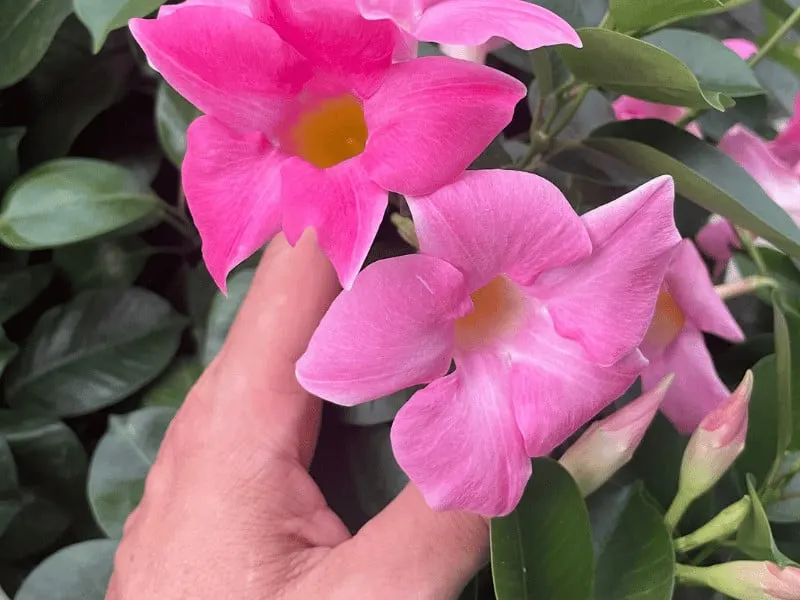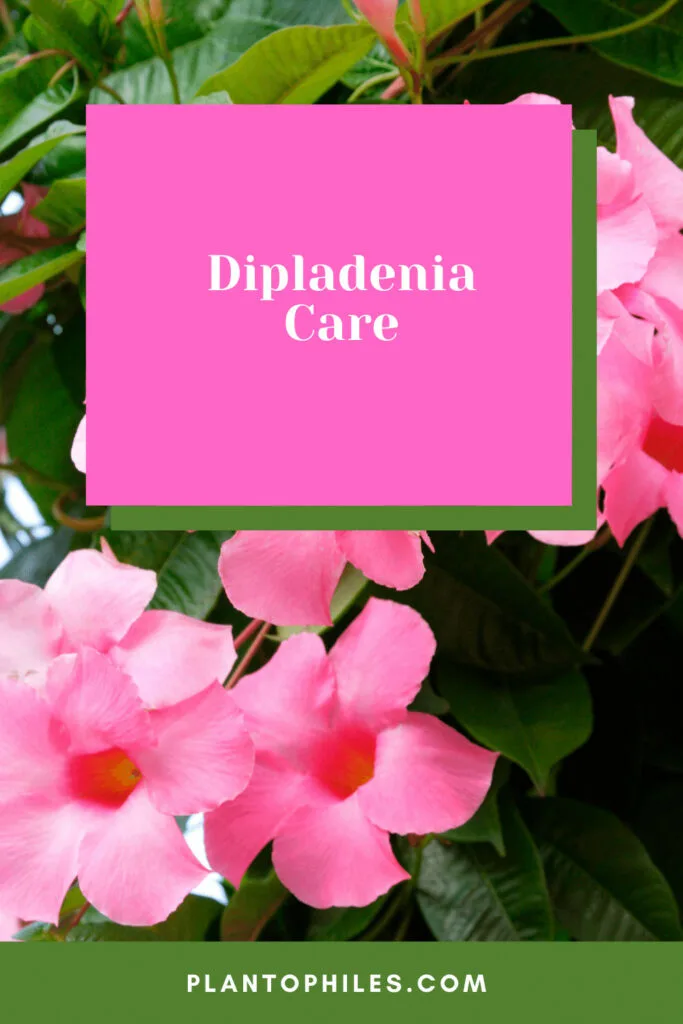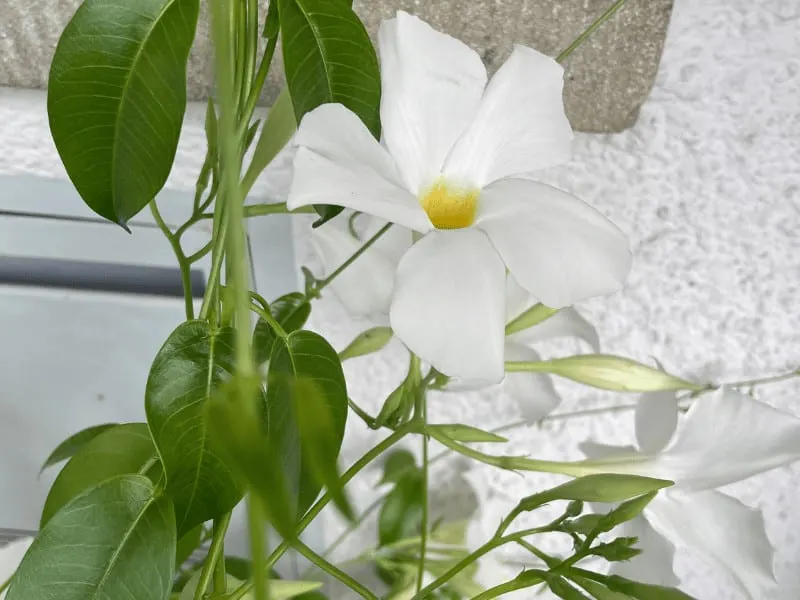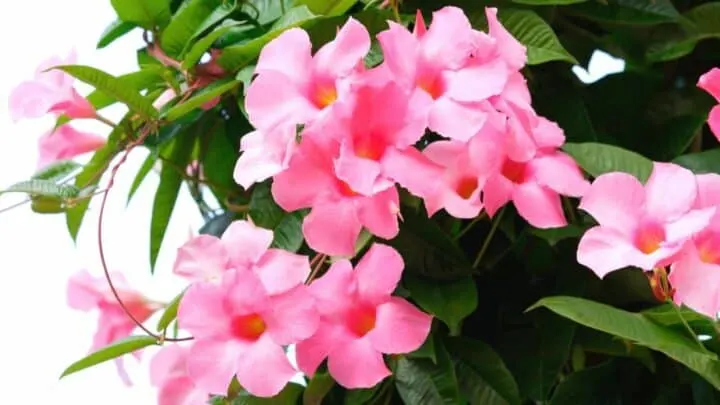You are interested in Dipladenia care and want to learn more about the Mandevilla plants. For many years I grow these flowers in my garden. I am always so amazed by the beautiful flowers and their easy care.

| Species | Dipladenia |
| Synonyms | Mandevilla,Rocktrumpet |
| Family | Apocynaceae |
| Genus | Dipladenia |
| Growth | Climbing, Trailing |
| Height | 10 feet |
| Width | 6 feet |
| Soil | Well-draining. Loamy to sandy types of soil |
| Watering | Every 7 days |
| Light | Bright Indirect |
| Temperature | 60-80 °F (16-27°C) |
| Humidity | 40-60% |
| Fertilizer | Fertilize every 14 days in spring and summer |
| Propagation | Vine cuttings |
| Toxicity | Toxic. Dipladenia contain toxic sap leading to mild indigestion, excessive salivation, and diarrhea |
Table of Contents
Dipladenia Bush
Dipladenia is a beautiful bushy plant belonging to the Mandevilla genus.
These plants are more shrub-like than vine-like, according to Greenhouse Management.
Clemson University adds that Dipladenia was a name previously used for Mandevilla plants.
They are evergreen tropical vines and have several popular varieties.
Due to the shape of their flowers, these plants are commonly known as Funnel Flowers or Rocktrumpets.
These plants are natives of Brazil, Northern and Southern America, Mexico, and the West Indies.
Previously, the larger plants were called Mandevilla, while the small, bushier varieties were known as Dipladenia.

Presently, they are all classified as the same genus.
Overall, the genus includes up to 200 different tropical species and hybrids.
These plants are somewhat different from Mandevilla plants, though.
Their leaves are a darker green. They have fine, pointed leaves that also appear slightly glossy.
Dipladenias have a fuller shape and look more like a shrub.
Their flowers are also smaller in comparison to those of the Mandevilla.
Dipladenia Care
Dipladenia plants need at least 6 hours of direct sun per day. Well-draining, loamy, or sandy soil should be kept moist. Water once every eight to ten days and feed once in the spring with a slow-release fertilizer. Humidity between 40-60% is fine. Temperatures must be above 65℉ (18.3℃).

What Soil is best for Dipladenia?
Dipladenia needs loamy to sandy types of soil. They should be kept moist but not wet or soggy. Drainage is important. The soil should be free to well-draining. Preferential soil pH levels are from 6.6 to 7.8. A humidity between 40-60% is preferred.
These plants can be grown indoors or outdoors. However, these plants are known to do better when kept indoors.
They prefer a moist, free-draining soil type when potted or planted directly in the ground.
Ideally, a sandy or loamy type of soil should be used.
These plants also prefer a soil pH level of between 6.6 and 7.8.
These houseplants are slightly lenient and can grow in soils outside this pH range. Generally, store-bought potting soils will suffice.

What Light is best for Dipladenia?
Dipladenias need a lot of light to thrive. Direct to partial sun is advisable for best growth. A minimum of 6 hours of sun exposure per day is recommended. Adequate sun exposure keeps this plant healthy and encourages flowering. In hot climates, avoid extended exposure to harsh sun rays.
As tropical plants, they enjoy the sun. They grow their best in full, direct sun to partial sun.
When grown indoors, a brightly lit windowsill is preferential.
Ideally, these plants need between six and eight hours of sun daily.
It is important to keep your plant in a well-lit spot.
Doing so will not only ensure your plant remains healthy. It also encourages these plants to flower.
In very hot climates, placing your plant in a partially shaded location is recommended.
Extended direct exposure to the harsh sun rays may lead to the leaves being scorched.
How to water a Dipladenia
Water your Dipladenia deeply and thoroughly every eight to ten days or so. Water more frequently in warm weather. They like to be kept moist but not overly wet. Avoid overwatering this plant, as it will likely lead to root rot. They have a slight tolerance to drought as they store moisture in their roots.
In warmer weather, it may be necessary to water them more frequently.
They prefer their soil to be kept somewhat moist. However, too much water will likely lead to your plant contracting root rot.
Although moisture is desirable, some dryness is acceptable.
This is because these houseplants are capable of storing moisture in their roots.
These plants are better equipped to deal with short periods of drought than when faced with too much water.
It is best to water your houseplant deeply and thoroughly.
Doing so allows the water to soak into the plant’s soil and be absorbed.
Any excess water should drain out and can then be discarded. Do not let your plant sit in a pool of water.
What is the ideal Temperature for Dipladenia?
Dipladenias thrive in warm temperatures. They are not very cold-tolerant plants and are not frost-hardy. These tropical plants should be kept at temperatures above 65℉ (18.3℃). If temperatures drop below this, the plant must be overwintered indoors.
Coupled with their love for the sun, Dipladenias grow best in warm temperatures.
These plants do not have much tolerance for cold temperatures. They are also not frost-hardy.
The ideal temperatures for your Dipladenia plants are 70℉ (21.1℃) and above.
Nighttime temperatures should remain around 65℉ and 70℉ (18.3℃ and 21.1℃).
Anything below these temperatures and your plant will likely suffer damage from the cold.
Because of their low tolerance for the cold, Dipladenias should be overwintered indoors.
Humidity for Rocktrumpets
Dipladenia is thought to grow well in a humidity between 40-60%. In very dry climates, misting your plant is advisable. Mist your Dipladenia occasionally to increase the humidity level around it.
Dipladenias are not fussy when it comes to humidity. They are thought to grow just fine in a range of levels.
If the air around your plant is excessively dry, misting may be required.
Mist your Dipladenia occasionally during dry spells to increase the humidity around it.
How to Fertilize My Dipladenia?
Fertilize Dipladenia every 14 days in spring and summer using a well-balanced liquid fertilizer.
Dipladenia is recommended to only be fed during its growing period in spring and summer. These plants are not heavy feeders. A slow-release fertilizer can be applied once in spring.
These plants should only be fed during their growing period. After they stop flowering, Dipladenias go into a period of dormancy.
During this time, the plant is not actively growing and will be unable to use the plant food.
Feeding the plant when it cannot use the food can harm it. Unused fertilizer will likely burn the roots of your Dipladenia.
How do Dipladenias Grow?
Dipladenia grows upwards to a point, then changes and grows downwards. They are bushy, shrub-like plants that can be grown as annuals or perennials. They have funnel-shaped flowers and glossy, dark green foliage. Flowers bloom continuously throughout the year, but the plant is evergreen.
These tropical vines grow to form a bushy, shrub-like plant.
They have dark green, glossy foliage which grows along wandering stems. Dipladenias are classified as annual and perennial plants.
In unfavorably cold climates, these plants are generally overwintered.
In climates where they can be grown as perennials, Dipladenias are evergreen. They are flowering plants. They are known to flower on and off throughout the year.
Dipladenias have an interesting habit of growth. At first, they grow upright until they reach a certain height.
Once this height has been reached, their vines begin to grow downwards.
This unique habit makes them ideal candidates for hanging baskets, planters, or on the edge of raised garden beds.
It isn’t easy to measure how large these plants can grow because of their growth habit.
It is known, however, that when grown with aid, they can reach up to 16.4 feet (5 meters) high.
Mandevilla Potting
Dipladenia should be repotted annually in the spring. They grow well in containers such as pots and hanging baskets. When repotting, only increase the container size by one. An oversized pot will lead to the plant spending more energy on growing roots than producing flowers.
Due to their temperature preferences, Dipladenias are best grown in pots.
This makes it easy to move them around as needed. Move them out of the harsh sun or bring them indoors to protect against the cold.
These plants grow well in a variety of containers. This is due to their upwards and downwards habit of growth.
From regular pots to hanging baskets, and even planters, these plants look great!
You will know it is time to repot your Dipladenia when you see its roots begin to grow out the bottom of its pot.
Typically, you can expect to repot your plant annually.
As with most plants, it is best to repot the Dipladenia in the spring.
The new pot you choose for your Dipladenia should be just one size bigger than the current pot.
Repotting this plant in an overly big container will use more energy to grow roots.
This will result in your plant not flowering as it typically would.
How to Prune a Dipladenia
Pinch back new growth to encourage bushier regrowth of Dipladenia. When needed, remove dead or damaged leaves. Trimming may also be needed occasionally to maintain a desired shape or size.
Dipladenias are low-maintenance plants when it comes to their pruning needs. They do not require much attention to look their best.
Generally, simply pinching back new growth will be enough to keep your Dipladenia in tip-top shape.
This will also encourage your plant to grow back bushier.
Occasionally, some trimming may be done to keep the plant at a desired shape or size.
Dead or damaged leaves should be removed as and when necessary.
Dipladenia Propagation
Propagating Dipladenia is best done using vine cuttings. Take a cutting from a healthy, mature plant. Remove lower leaves, rinse, and allow to dry. Plant the cutting in a free-draining potting mix. Keep the newly planted cutting in a bright, warm spot with moist soil until roots have developed.
Dipladenias is one of the easiest plants to propagate.
The best way to propagate Dipladenia is through vine cuttings. The process is simple and typically successful.
Using a pair of sharp, clean gardening shears, take a cutting from a healthy, mature plant.
Remove the leaves from the bottom part of the vine cutting. If necessary, rinse the cutting to remove any dripping sap.
Allow the cut part of the vine to dry, then plant it in a well-draining potting mix.
Place your newly planted cutting in a warm spot with enough light.
While the cutting develops roots, its soil should be kept moist.
This is best done by lightly misting the soil. Once the Dipladenia cutting has roots, you can care for it like a full-grown plant.
When in season, the Dipladenia’s blooms appear as delicate funnel-shaped accessories.
Dipladenia Flower
Dipladenia cultivar blooms are large and available in white, red, and pink. The blooms are trumpet-shaped. The colder the environment, the shorter the blooming period.
Common problems
With proper care and maintenance, Dipladenias rarely suffer from many pests or disease problems.
The most common disease to be contracted by these plants is root rot.
The contraction of root rot is likely the result of an error in care. Incorrect soil, insufficient drainage, or overwatering are all possible causes of root rot.
Unfortunately, these plants are known to draw the attention of spider mites and aphids.
These pests are easily dealt with, however.
Simply wipe your Dipladenia leaves gently with a cotton swab and neem oil. Insecticides can also be used successfully against these pests.
My Dipladenia Leaves are Turning Brown
Several factors can lead to the browning of Mandevilla leaves, such as inconsistent watering, environmental stress, bacterial wilt, and fungal attacks.
Although inconsistent watering is often the primary cause, it’s essential to recognize that multiple factors can contribute to the discoloration of your Mandevilla leaves.
Frequently Asked Questions About Dipladenia
Are Dipladenia plants toxic?
Yes, these plants are considered toxic for humans and pets. It is best to keep them away from curious children and animals.
What are the best Dipladenia varieties?
There are many beautiful types of Dipladenias available. The most popular varieties, however, include the Rio White, Cream Pink, and Opal Citrine.
Conclusion
Dipladenias are tropical, evergreen beauties.
Although they can be slightly more demanding where their care requirements are concerned, they are worth the effort!
When in bloom, these plants bring a unique elegance to an area.
And, with their alternative growing habit, they draw all the attention to themselves.

Daniel has been a plant enthusiast for over 20 years. He owns hundreds of houseplants and prepares for the chili growing seasons yearly with great anticipation. His favorite plants are plant species in the Araceae family, such as Monstera, Philodendron, and Anthurium. He also loves gardening and is growing hot peppers, tomatoes, and many more vegetables.


